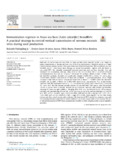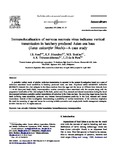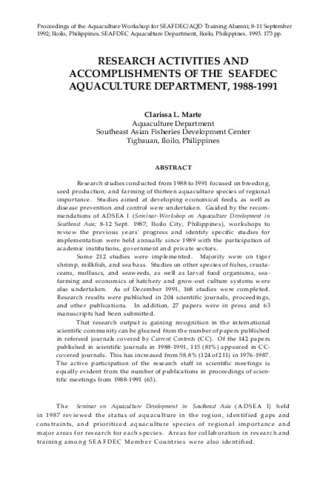| dc.contributor.author | Pakingking, Rolando V., Jr. | |
| dc.contributor.author | Seron, R. | |
| dc.contributor.author | de la Peña, Leobert D. | |
| dc.contributor.author | Mori, K. | |
| dc.contributor.author | Yamashita, H. | |
| dc.contributor.author | Nakai, T. | |
| dc.date.accessioned | 2014-05-27T02:58:30Z | |
| dc.date.available | 2014-05-27T02:58:30Z | |
| dc.date.issued | 2009 | |
| dc.identifier.citation | Pakingking Jr., R., Seron, R., dela Peña, L., Mori, K., Yamashita, H., & Nakai, T. (2009). Immune responses of Asian sea bass, Lates calcarifer Bloch, against an inactivated betanodavirus vaccine. Journal of Fish Diseases, 32(5), 457-463. | en |
| dc.identifier.issn | 0140-7775 | |
| dc.identifier.uri | http://hdl.handle.net/10862/2098 | |
| dc.description.abstract | Asian sea bass, Lates calcarifer (Bloch), exhibited strong immune responses against a single injection of the formalin-inactivated red-spotted grouper nervous necrosis virus (RGNNV), a betanodavirus originally isolated in Japan. Fish produced neutralizing antibodies at high titre levels from days 10 (mean titre 1:480) to 116 (1:1280), with the highest titre at day 60 post-vaccination (1:4480). When fish were challenged with the homologous RGNNV at day 54 post-vaccination, there were no mortalities in both the vaccinated and unvaccinated control fish. However, a rapid clearance of the virus was observed in the brains and kidneys of vaccinated fish, followed by a significant increase in neutralizing-antibody titres. Furthermore, the vaccine-induced antibodies potently neutralized Philippine betanodavirus isolates (RGNNV) in a cross-neutralization assay. The present results indicate the potential of the formalin-inactivated RGNNV vaccine against viral nervous necrosis (VNN) of Asian seabass. | en |
| dc.description.sponsorship | We would like to thank Dr. Gilda Lio-Po for giving valuable suggestions on this study. We also gratefully acknowledge Dr. Evelyn Grace de Jesus-Ayson and some staff of Finfish Hatchery and Biolab for their kind assistance during the experiment. This study was funded in part by the Government of Japan Trust Fund through the Regional Fish Disease Project (study code: 8001-T-FT-FH0507) and by a Grant-in-Aid for Scientific Research (No.18076) from the Ministry of Agriculture, Forestry and Fisheries of Japan. | en |
| dc.language.iso | en | en |
| dc.publisher | Blackwell Publishing | en |
| dc.subject | Dicentrarchus labrax | en |
| dc.subject | Lates calcarifer | en |
| dc.subject | Japan | en |
| dc.subject | Philippines | en |
| dc.title | Immune responses of Asian sea bass, Lates calcarifer Bloch, against an inactivated betanodavirus vaccine | en |
| dc.type | Article | en |
| dc.citation.volume | 32 | |
| dc.citation.issue | 5 | |
| dc.citation.spage | 457 | |
| dc.citation.epage | 463 | |
| dc.citation.journalTitle | Journal of Fish Diseases | en |
| dc.subject.asfa | marine fish | en |
| dc.subject.asfa | antibodies | en |
| dc.subject.asfa | fish diseases | en |
| dc.subject.asfa | viral diseases | en |
| dc.subject.asfa | disease control | en |
| dc.subject.asfa | vaccines | en |
| dc.subject.asfa | mortality causes | en |
| dc.subject.asfa | mortality | en |
| dc.subject.asfa | necrosis | en |
| dc.subject.asfa | brain | en |
| dc.subject.asfa | kidneys | en |
| dc.subject.asfa | vaccination | en |
| dc.identifier.essn | 1365-2761 | |
| dc.identifier.doi | 10.1111/j.1365-2761.2009.01040.x | |
| dc.subject.scientificName | Lates calcarifer | en |



